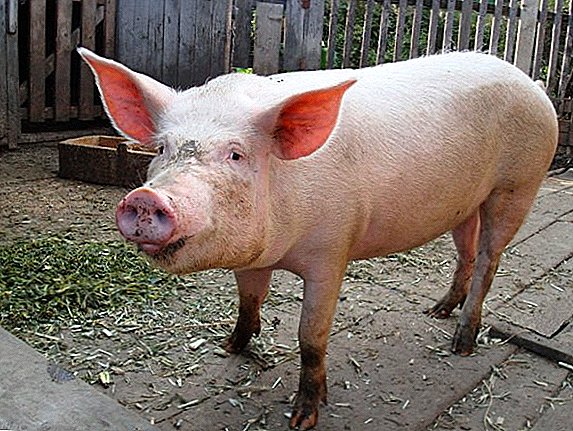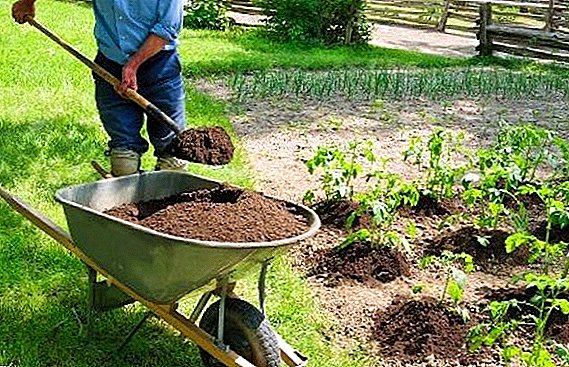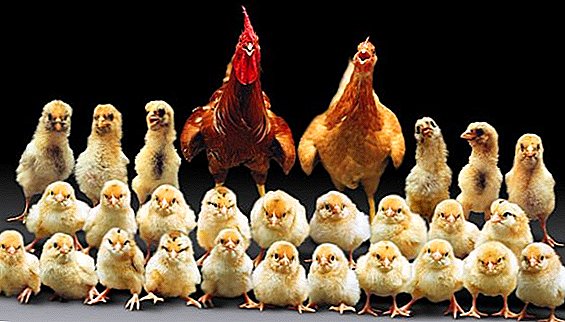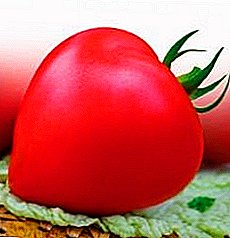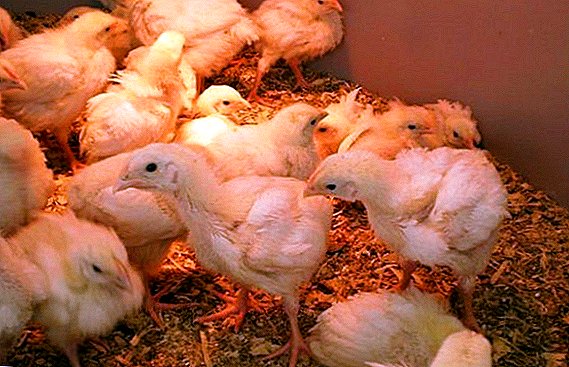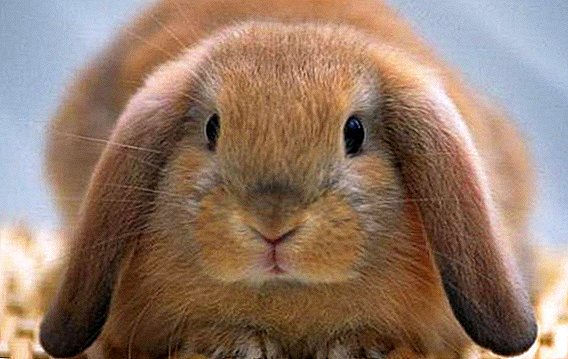 Adding to the rabbit family is a welcome event in the household of each farmer.
Adding to the rabbit family is a welcome event in the household of each farmer.
However, this event also brings a lot of trouble and excitement - after all, health, weight gain and the development of eared offspring depend on how much a “dairy” female is.
We have prepared for you useful information about how lactation occurs in rabbits.
How many rabbit feeds rabbits milk
Most often, the rabbit gives birth to 5-7 rabbits per okol. Exact numbers, above all, depend on its pedigree affiliation, state of health, as well as the number of previous genera - if the offspring is the first, then there will be less babies.  Rabbits are born small, blind and almost bald, so in the first days of their lives they are in dire need of mother's warmth and her nourishing milk. If the female has no lactation disturbances, then she is immediately ready to feed her offspring - this process takes 5-10 minutes.
Rabbits are born small, blind and almost bald, so in the first days of their lives they are in dire need of mother's warmth and her nourishing milk. If the female has no lactation disturbances, then she is immediately ready to feed her offspring - this process takes 5-10 minutes.
During the day she feeds 1-2 times, mostly in the dark.
Milk productivity reaches its peak at 19-21 days after caout, and then the amount of milk produced begins to decline. This means that after the rabbit is 14 days old, you can begin to introduce complementary foods - dry food, dried herbs, cereals, as well as mineral supplements and vitamins.
It is important to remember that the new food should be finely chopped or chopped, each ingredient should be added to the diet in turn - no more than once every three days.
The most common age of weaning babies from mothers is 2 months. At this age, rabbits should be able to independently eat and chew food from the daily diet of adults.
Important! The nature is so laid down that the rabbit should have enough milk for all the offspring, however, if the number of cubs exceeds 8 individuals, then the rest of the newborns should be distributed among other females that feed a smaller number of rabbits.
The composition and beneficial properties of milk
The rabbit's milk is very different from the milk of other animals in its chemical composition, caloric content and nutritional value.  It contains the following beneficial substances:
It contains the following beneficial substances:
- protein - 11.5%;
- fats - 11.2%;
- sugar - 0.9%;
- mineral substances - 2.4%;
- dry matter - 26.5%.
Such a rich chemical composition explains such a rapid growth and weight gain in baby rabbits in the first month of life. The amount of proteins and minerals in rabbit milk is several times more than cow milk products contain.
Did you know? Rabbits can get sick from loneliness, especially decorative rocks are sensitive to this. To brighten up leisure eared pet, buy toys for him that will not let him get bored.
How to check if the rabbit has milk
For the health and full development of the offspring, it is very important to determine in the first days after birth whether the rabbit has improved lactation.
Important! If you have determined that after capping the female has little or no milk, do not despair. The introduction of oxytocin can help improve its lactation. However, to obtain the expected effect, injections should be made no later than 48 hours after delivery and under the supervision of a veterinarian.
Experienced rabbit breeders can determine the degree of "milkiness" of eared mom in two ways:
- In appearance and behavior of rabbits. If you notice that babies are crawling in different directions, their bellies are soft, and the fur on the stomach is wrinkled and has an untidy appearance, then they definitely lack food. Inspect the rabbits every day to prevent them from lagging behind in development and weight gain.
- In appearance nipples rabbit. The main symptom of arrived milk is their swelling. The place around the nipples should be plucked - the female pulls out the fur on her stomach in order to cover her nest, prepared for posterity. You can also try to gently press on the nipple - a drop of white should separate from it, but the release of a clear liquid is also allowed.

What to feed to increase lactation
One of the main causes of insufficient milk in rabbits is considered an inadequate diet. After caulking, the female needs an increase in daily rations - approximately 10 g of food eaten "goes" to produce 1 g of milk for newborn offspring.
As you can see, the restriction in the diet of a female can nullify the lactation process.
Did you know? Decorative rabbits are very clean - they wash themselves 5-6 times a day. However, if you notice an unpleasant smell from your pet, this may indicate problems with his health.
If you have determined that the cause of insufficient lactation in a rabbit lies in malnutrition, then this process can be adjusted by means of a small adjustment of her daily diet:
- Combined mixers of bran and alfalfa, corn (corn cobs can be used) and barley, as well as alfalfa, bran and boiled potatoes. Potato mixes are a very nutritious food that perfectly saves many breeders in the winter season, when it is especially important to monitor the diversity in the diet of their pets. Potatoes can be given both raw and cooked. When preparing a bran-based mash, be sure to add drinking water to them - it will be easier to eat them.
- Herbs that stimulate milk production: dill, parsley, anise. Try not to give the same kind of grass every meal. Such herbs should be 30-50% of the total grass collection in the rabbit bowl. Feel free to combine them with clover, dandelion, young nettle and other herbs that grow in your area.
- Roots: beet, Jerusalem artichoke, carrot and rutabaga. Before serving, they must be well washed under running water, if necessary, the roots are cut into small pieces.
- Clean drinking water at room temperature. Regularly change the water in the drinker, and in winter it is important to give the rabbits, especially pregnant and lactating females, slightly heated water.

How to replace the rabbit's milk
Sometimes farmers are faced with the fact that they have to independently feed their newborn offspring. The reasons for this may be different - female disease, lack of maternal instinct, or the death of a rabbit after childbirth.
Saving babies without mother-feeding is a very difficult process that requires constant attention. The surest way is to try to shift the rabbits to another female feeding their babies.
If this does not work out, try using rabbit milk substitutes, which we will tell you next.
Powdered milk
We are talking about dry bitch milk - powder for breeding water, which feed newborn puppies left without a nursing bitch. It can be purchased at any veterinary pharmacy. The composition of the mixture as close as possible to the mother's milk, so the harm such food is unlikely to bring.
Dry substitute is diluted with boiled water in accordance with the instructions on the package. The main condition that applies to any rabbit milk substitute product is mandatory heating to a temperature of + 36-37 ° C.
Cow's milk
The most readily available substitute for rabbit milk is cow milk, but its fat content is not sufficient for the full development of baby rabbits, so it is customary to dilute it in equal proportions with condensed milk. The daily rate of this mixture is 5 ml. Optimally feed babies 1 ml at a time.  Use a pipette, syringes without needles (most conveniently - insulin) for this, or special syringes for feeding puppies or kittens can be purchased at veterinary pharmacies.
Use a pipette, syringes without needles (most conveniently - insulin) for this, or special syringes for feeding puppies or kittens can be purchased at veterinary pharmacies.
It should be noted that undiluted cow's milk will only harm the immature gastrointestinal tract of baby rabbits, and in the rabbits of ornamental breeds it can even cause severe poisoning, which is often fatal.
For decorative rabbits include such breeds as hermelin, squirrel, lionheaded rabbit, colored short-haired dwarf, Viennese blue.
Many breeders are categorically against feeding newborn rabbits with cow's milk - due to the difference in chemical composition and the amount of nutrients and trace elements. In cases of feeding babies without the help of a female, experts recommend using goat milk.
The feeding pattern is slightly different from the previous one - 2 ml at a time twice a day. The only disadvantage of such a substitute is that it is not so easy to get it if you live far from villages and livestock farms.
In the conditions of the need to leave newborn offspring left without a nursing female, first of all, the most affordable substitutes are used, including cow's milk.
Rabbits fed artificially - with the use of substitutes - will not be distinguished by a large weight and its strong appearance. But, you see, such a result is definitely better than the loss of the whole eared brood.
Especially important for the preservation of the health of baby rabbits will be their feeding in the first 4-5 days of their life.



